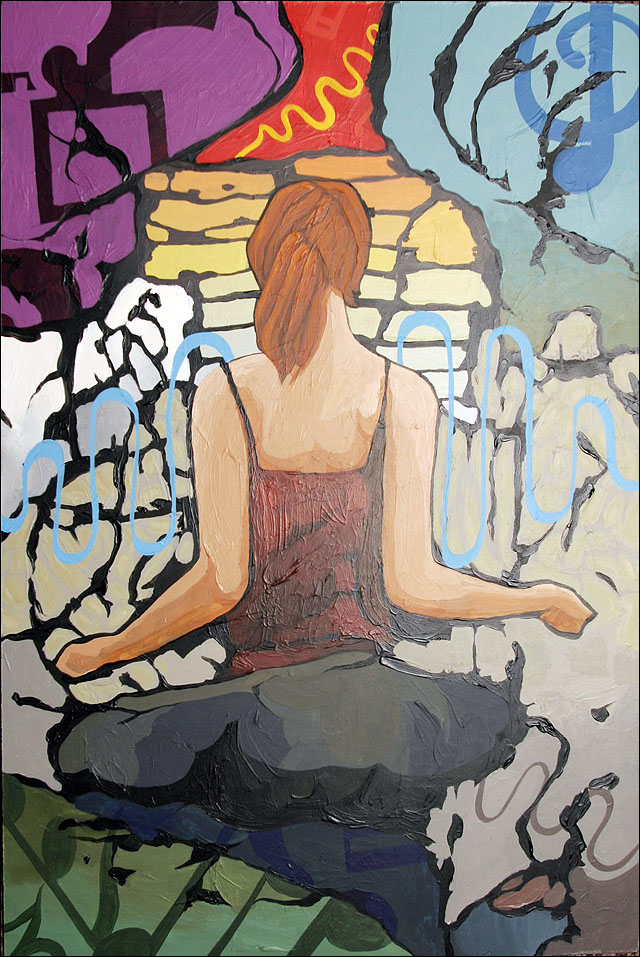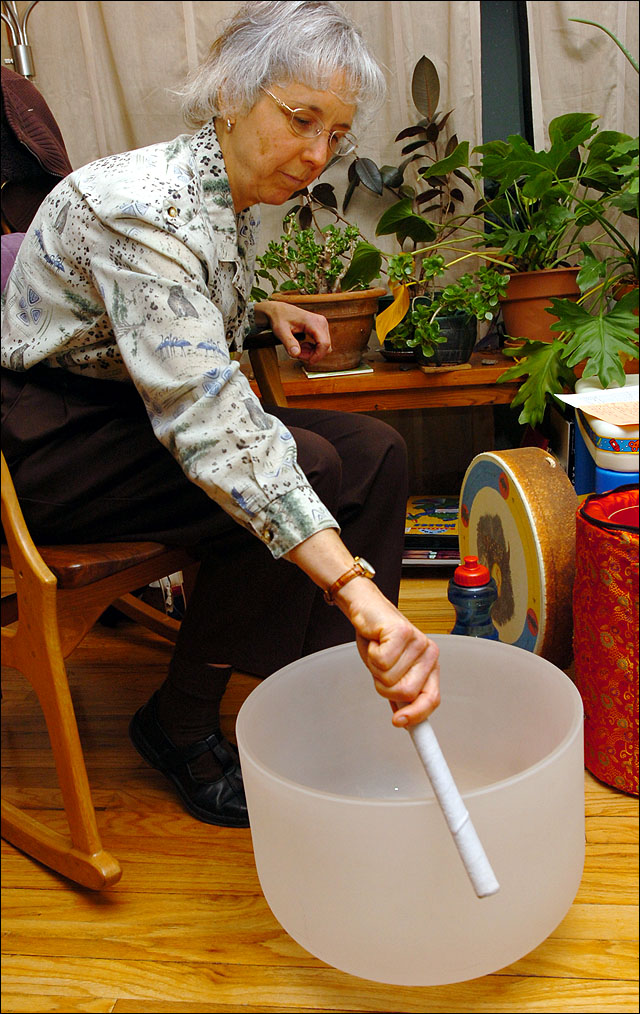Healing power of sound
Vocal therapy releases tension, stress
The living room is throbbing with sound waves from a large singing bowl.
It’s like the sound made when rubbing your fingers over the rim of crystal glasses – only much louder and much more intense, to the point you feel it in your body.
Five people, sitting in a chair, on a couch and on the floor, are chanting various syllables, for several minutes at a time before switching to a new syllable. They pick different pitches and chant for different lengths of time.
“Ohm.” “Ooh.” “Uh.” “Ah.” “Ah-Eeh.”
They switch to phrases.
“I am love.” “You are love.” “We are love.”
This is Sound Pod, a form of meditation and energy healing that participants say can bring inner peace and even physical healing. It’s been popular on the coasts for several years. Now, it’s hit Lawrence.
Sound healing
Becky Clark, a 1997 graduate of Kansas University’s music therapy program and activity director for the women’s prison in Topeka, has been dabbling in sound therapy for several years.

She’s offered individual sessions of sound therapy, which involves using singing bowls, tuning forks and other instruments to vibrate specific parts of the body. It’s meant to balance energy in the body and release “chi” energy, something some believe creates a feeling of overall well-being.
She says a client of hers claims to have been cured of a heart arrhythmia after a session.
The Sound Pod meetings are an outgrowth of her sound work with individuals. She started leading the meetings in September at her house in Topeka, on the second Monday of the month, and in November at a participant’s house in Lawrence, on the second Thursday of the month.
“It creates a deeper awareness of their bodies and the world around them,” Clark says. “It will bring a peace they didn’t have when they came. It’s definitely a meditative experience.”
Good vibrations
In addition to the vowel-syllable chanting, a typical 90-minute session involves “grounding exercises,” such as deep breathing and making random exhale noises to get rid of stresses of the day; chanting in other languages; and hearing Clark provide a “sound journey” with meditative words, singing and a beating drum.
Clark stresses that a beautiful singing voice is not required for the sessions.
The philosophy behind the experience, Clark says, is vibrating the body through hearing and making sounds that create positive energy, which raises awareness of self and the outside world. Because it’s a form of meditation, she says, it also helps “center” participants and makes them feel better physically, mentally, emotionally and spiritually.

Becky Clark, a 1997 graduate of Kansas University's music therapy program and activity director for the women's prison in Topeka, plays a singing bowl before a recent sound therapy session. She leads a Sound Pod once a month in Lawrence.
“The overall goal is to raise our vibration – our individual and group vibration – in a way that will enhance our journey on the earth,” she says.
Brian Fife, who participated in a Sound Pod meeting this week in Lawrence, says he felt “lighter” from the experience.
“For me, I know I have (stress) issues,” he says. “This is one way to work through them. Grounding at the beginning is a way of admitting to yourself the issues you have and leaving them at the door. Sound therapy is a way of imagining you’re living without those issues.”
Fife says he meditates on a regular basis by himself, but doing it as a group alters the experience.
“It’s good to have as many tools as you possibly can,” he says. “Why limit yourself?”
Tension release
Not everyone subscribes to the belief of using positive energy to heal, or that energy from the earth and heavens is tied to physical well-being.
But the principles of using sound as a therapy tool actually are rooted in scientifically tested theories, says Alicia Ann Clair, director of the music therapy department at KU.
She notes that Sound Pod is not music therapy. Music therapy is generally ordered after a referral from a doctor, has specific health goals in mind and has results that can be measured. An example is playing music to help a stroke victim recover his or her even walking gait.
Still, she says, vocalizing does have its benefits.
“With what (Clark) is doing, she’s providing a way for people to have some emotional expression and release,” Clair says. “It’s no different than if you learn to play the piano, and when you sit down at the keyboard and feel very satisfied, calm and very aesthetically pleased.”
Deep breathing required by singers helps oxygenate the body, Clair says, and the vocalization process helps release tension.
“I think what Becky does, even if you don’t believe in that energy business or the orientation she’s talking about, can provide a release of emotions that can be very helpful,” Clair says.
Clark says she hopes the Sound Pod experience catches on in Lawrence. She says she can tell a difference in the way she feels every time she participates.
“I always get really warm because I stir up this energy,” she says. “I feel this energetic, expanded feeling in my body. I can get centered if I’m scattered with the things of the day.”
She says Neil Diamond’s “Song Sung Blue” says it best – that singing the blues lets you release them from your body.
“They sing about their sorrows, and they feel better,” she says. “It gives them a way to feel their emotions.”


